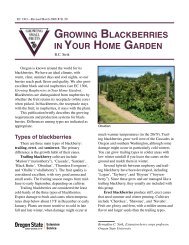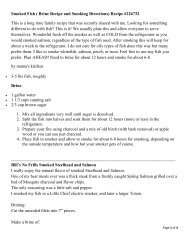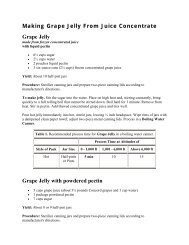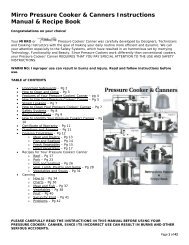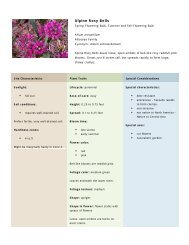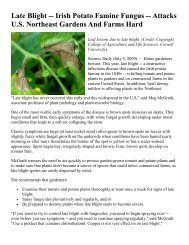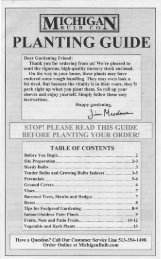Strawberry and Raspberry Pest Management in Wisconsin
Strawberry and Raspberry Pest Management in Wisconsin
Strawberry and Raspberry Pest Management in Wisconsin
You also want an ePaper? Increase the reach of your titles
YUMPU automatically turns print PDFs into web optimized ePapers that Google loves.
Table 8. Weed management for strawberries (cont<strong>in</strong>ued)<br />
Tim<strong>in</strong>g Commercial product, rate/acre Active <strong>in</strong>gredient, rate/acre Remarks<br />
NONBEARING BEDS (cont<strong>in</strong>ued)<br />
Late fall<br />
(Oct. 15–Nov. 1)<br />
BEARING BEDS<br />
Chateau WDG, 3 oz flumioxaz<strong>in</strong>, 0.096 lb Apply <strong>in</strong> late fall after strawberry plants are fully dormant. This<br />
treatment should provide control through harvest the follow<strong>in</strong>g<br />
year. You must have the supplemental label <strong>in</strong> your possession<br />
at application. See label for maximum annual use rate.<br />
Dacthal W-75, 8.0–12.0 lb DCPA, 6.0–9.0 lb Preemergence. Best applied <strong>in</strong> early spr<strong>in</strong>g or late fall. Can<br />
be lightly <strong>in</strong>corporated with irrigation, ra<strong>in</strong>fall, or tillage. Most<br />
active aga<strong>in</strong>st annual grasses.<br />
Devr<strong>in</strong>ol<br />
10G, 40.0 lb; or<br />
50DF, 8.0 lb<br />
napropamide, 4.0 lb Preemergence. A fall application should provide weed<br />
control until after fruit production the follow<strong>in</strong>g year. Devr<strong>in</strong>ol<br />
is <strong>in</strong>activated by sunlight (ultraviolet), so field must receive<br />
1/2 <strong>in</strong>ch of irrigation or ra<strong>in</strong>fall with<strong>in</strong> 24 hours of treatment.<br />
Devr<strong>in</strong>ol may <strong>in</strong>hibit runner root<strong>in</strong>g.<br />
*Gramoxone Inteon, 2.0 pt paraquat, 0.5 lb Postemergence. Apply by direct<strong>in</strong>g spray between the rows<br />
us<strong>in</strong>g shields to prevent contact with the crop. Do not allow<br />
spray to contact strawberry plants or fruit as <strong>in</strong>jury or<br />
excessive residues may result. Do not exceed three<br />
applications per year.<br />
S<strong>in</strong>bar 80WP, 2.0–4.0 oz terbacil, 0.1–0.2 lb Preemergence. Individual application <strong>and</strong> maximum annual<br />
use rates vary by soil type <strong>and</strong> application tim<strong>in</strong>g. See label<br />
for details. Apply before putt<strong>in</strong>g on w<strong>in</strong>ter mulch.<br />
See comments on S<strong>in</strong>bar above.<br />
Prowl H 2O, 1.5–3.0 pt pendimethal<strong>in</strong>,<br />
0.7–1.4 lb<br />
Early spr<strong>in</strong>g 2,4-D am<strong>in</strong>e 2,4-D (rate varies<br />
by label)<br />
May be applied dur<strong>in</strong>g fall or w<strong>in</strong>ter dormancy, prior to onset<br />
of new seasonal growth. Do not apply if new seasonal growth<br />
(leaves) have emerged or are exposed. Use rate varies by soil<br />
type. Do not exceed 6.0 pt/a per season. Do not apply with<strong>in</strong><br />
35 days of harvest. Stunt<strong>in</strong>g, reduced growth, or reduction <strong>in</strong><br />
daughter plants may occur with this use. Supplemental label<br />
expires December 31, 2009.<br />
Postemergence. Apply before the strawberry plants have<br />
made much new growth if d<strong>and</strong>elions are present <strong>in</strong> great<br />
numbers. Choose a nonw<strong>in</strong>dy day for this application. Use low<br />
pressure <strong>and</strong> large droplet size to m<strong>in</strong>imize herbicide drift.<br />
Temporary distortion of strawberry plants may occur.<br />
Chateau WDG, 3 oz flumioxaz<strong>in</strong>, 0.096 lb Preemergence. Treat <strong>in</strong> early spr<strong>in</strong>g to fully dormant strawberry<br />
plants to prevent crop <strong>in</strong>jury. Should provide control<br />
through harvest. Rotate with other chemistries at renovation.<br />
You must have the supplemental label <strong>in</strong> your possession at<br />
application. See label for maximum annual use rate.<br />
Dacthal W-75, 8.0–12.0 lb DCPA, 6.0–9.0 lb Preemergence. Best applied <strong>in</strong> early spr<strong>in</strong>g or late fall. Can<br />
be lightly <strong>in</strong>corporated. Most active aga<strong>in</strong>st annual grasses.<br />
Devr<strong>in</strong>ol<br />
10G, 40.0 lb; or<br />
50DF, 8.0 lb<br />
napropamide, 4.0 lb Preemergence. If either Devr<strong>in</strong>ol or S<strong>in</strong>bar was applied <strong>in</strong> the fall,<br />
don’t use additional herbicides <strong>in</strong> the spr<strong>in</strong>g. If neither product<br />
was applied <strong>in</strong> the fall, an application may be made<br />
immediately after mulch removal <strong>in</strong> the spr<strong>in</strong>g. Because this<br />
herbicide is <strong>in</strong>activated by sunlight (ultraviolet), the treated<br />
field must have 1/2 <strong>in</strong>ch of irrigation or ra<strong>in</strong>fall with<strong>in</strong> 24 hours<br />
after treatment. This treatment should give full-season control<br />
of most annual weeds. Runner root<strong>in</strong>g may be <strong>in</strong>hibited.<br />
29




